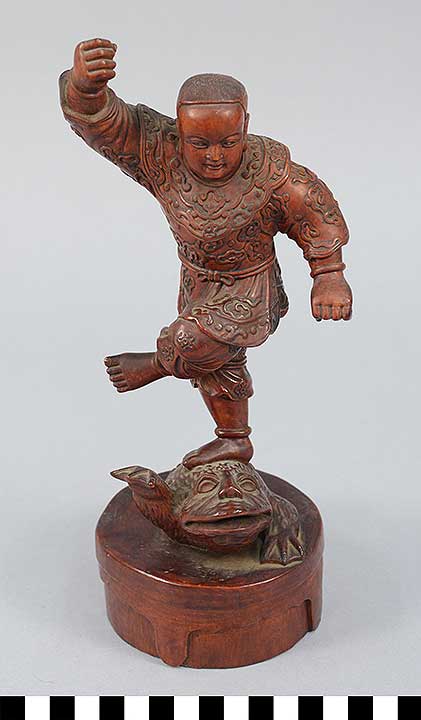Figure: Liuhai
2017.13.0001A
Detailed Images
Basic Information
| Artifact Identification | Figure: Liuhai (2017.13.0001A) |
|---|---|
| Classification/ Nomenclature |
|
| Artist/Maker | None |
| Geographic Location | |
| Period/Date | Cultural Revolution, 1966-1976 CE |
| Culture | N/A |
Physical Analysis
| Dimension 1 (Height) | 27.8 cm |
|---|---|
| Dimension 2 (Diameter) | 9.6 cm |
| Dimension 3 (N/A) | N/A |
| Weight | 543 g |
| Measuring Remarks | None |
| Materials | Plant--Boxwood, Varnish |
| Manufacturing Processes | Carved |
| Munsell Color Information | N/A |
Research Remarks
| Published Description | N/A |
|---|---|
| Description | A very fine and scarce Chinese boxwood carving of non-traditional Liuhai - as a young man, adorned with lavish pants and jacket in ancient military fashion, standing with his right leg on a toad (3-legged toad), his left leg raised, and he holds a spear in his right hand. Dating is Cultural Revolution, 1966-1976. The unusual drum carved base is part of the carving, 1 3/4” h., and the height to top of his raised hand which holds the spear 10 5/8”. |
| Comparanda | Lot 1288, A Boxwood Huangyangmu figure of Liuhai. 18th/19th century. Christie’s New York sale 2648: Auspicious Treasures for Scholars and Emperors: Selections from the Robert H. Blumenfield Collection. March 22, 2012. Lot 46, Good large bamboo carving of Liu hai, Qing Dynasty, 18th century. Sotheby’s New York sale 8420: Fine Chinese Ceramics and Works of Art. |
| Bibliography | N/A |
Artifact History
| Archaeological Data | N/A |
|---|---|
| Credit Line/Dedication | Fred A. Freund Collection |
| Reproduction | No |
| Reproduction Information | N/A |
